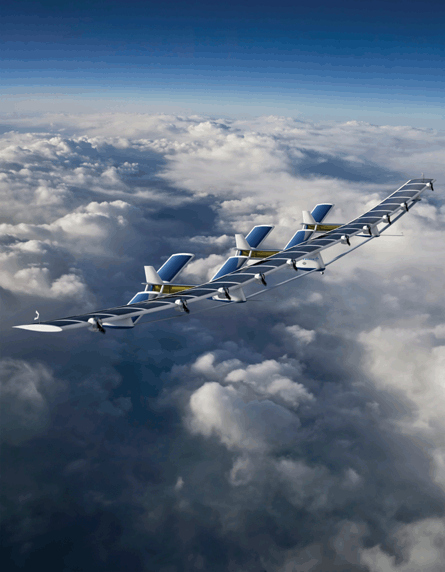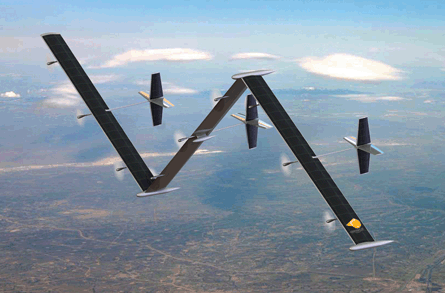Setting a goal to prove that a heavier-than-air aircraft can fly for more than five years without landing seems difficult enough, but perhaps raw longevity is really the easy part.
The US Department of Defense's research and development arm, Defense Advanced Research Projects Agency, which has invited bids to build the Vulture programme's near-full-scale demonstrator, considers its promise of extreme long endurance as shaking the foundations of how the military and the aerospace industry operate and support an aircraft.
"We hope to focus on the major paradigm shifts associated with this technology," says Dan Newman, DARPA's Vulture programme manager. "For example, Vulture can launch [its maiden operational flight] from the manufacturing facility and have no maintenance footprint. It offers a freedom from the types of impact that design changes have on a fleet of aircraft. There are no engineering change proposals, no retrofits, and no inherent burden for commonality across the fleet. As every airframe may be different, it blurs the line between recurring and non-recurring costs."
 |
|---|
© Lockheed MartinEach contractor proposed a slightly different concept: this is from Lockheed Martin |
If Newman's strategy prevails, the Vulture programme could introduce a new way for the US military to acquire, build and operate an aircraft. DARPA envisages Vulture launching after rolling off the production line and perhaps never touching the ground intact again. It would fulfil its five-year mission and simply destroy itself. The military-industrial complex's vast infrastructure to maintain and upgrade an operational aircraft would become suddenly unnecessary.
"There is an endurance [level] where it makes sense," Newman says. "You could launch this from a manufacturing facility and not have any bases for landing. Below that endurance [threshold] you might recover the aeroplane, repair and relaunch. We do not know what that endurance is. It may be different for each mission and payload."
The concept for Vulture also encourages competition. The DoD's acquisition policy encourages maintaining two or more suppliers for every need, but often struggles to pay for it. Vulture might require no maintenance or basing footprint to operate, Newman says, so the DoD could afford to keep several manufacturers building different types of ultra-long-endurance aircraft in business.
"A system like Vulture offers an opportunity for not only competitive prototyping," Newman says, "but competitive production."
Vulture could also dramatically change the way military officials look at the cost of space assets, Newman says. Compared with the bill for launching satellites into space, the cost of launching Vultures into their aerial orbits would be minimal, he says. "The infrastructure associated with ensuring that satellites work is a result of their significant launch costs," Newman says. "In the absence of launch costs, what would the satellite community look like in terms of design development and mission assurance?"
But Newman acknowledges that Vulture's theoretical advantages also create political risks for the programme. A system that challenges entrenched organisations can face resistance. As an aviation concept that promises space-like longevity and reach, Vulture will need to find support, despite having no obvious constituency. "Our challenge is today there's no home for a high-altitude, [ultra-] long-endurance system, especially as it departs from conventional systems," Newman believes. "It's not clear where in the services a system like Vulture will have a home."
Despite the potential controversy, DARPA wants to keep the Vulture programme focused on exploiting the advantages offered by an aircraft that performs like a satellite without the launch costs. Sticking with that objective could require rigid programme discipline, and refusing to compromise, for now, on any proposal to make the aircraft configuration possible to recover after completing its five-year mission.
"The programme is focusing on launch once, without recovery, because if we discuss recovery, we now begin [on] a slippery slope," Newman says. "The [phase 2] demonstrator will be recoverable just because of the idiosyncrasies of flight test. But the [objective] DARPA system is not recoverable, so that we can ensure we're focused on an asset without hardware footprint. As soon as you make it recoverable, some will plan to land it often."
Frequent landings could lead to problems such as "hangar crash", Newman adds, plus "all the issues associated with maintenance".
OPEN TO BIDDERS
DARPA launched Vulture in 2008 with contract awards to Aurora Flight Sciences, Boeing and Lockheed Martin. Each has proposed a slightly different concept for the Vulture to operate as an atmospheric satellite, flying more than 60,000ft (18,290m) over a target to collect intelligence or relay communications.
In Phase 2, DARPA will select a contractor to build a near-full-scale prototype, and fly it for up to three months. The agency is also opening Phase 2 to more bidders than the three selected in the first round. By coincidence, all three contractors for Phase 1 proposed a solar-electric configuration to power the aircraft.
DARPA had received multiple proposals for other types of power systems in Phase 1, and is opening the bidding in Phase 2 for other propulsion sources. Only nuclear-powered and lighter-than-air designs will be excluded from contract awards. Newman says other possibilities that could be considered include power beaming, laser microwaves and in-flight replenishment.
 |
|---|
© Aurora Flight Sciences |
DARPA has made several big changes to the programme's scope after Phase 1. The original plan called for a contractor to build a subscale demonstrator. As Vulture wanted to reduce as much risk as possible for the selection of an operational configuration, it made more sense to ask a contractor to build an aircraft to at least 90% of full-scale, Newman says. But Phase 2 now calls for "moving directly toward the very large flight article," says Newman. "We are increasing the focus on the maturation of this very large, very lightly-loaded structure. That's characterised by non-linear aero-elastic behaviour that couples with the flight controls. By moving more rapidly toward the very large aircraft, we're increasing the focus on that risk."
DARPA has budgeted $151 million for the Phase 2 contract, Newman says. It intends to make a single award, but could change the plan depending on how the offers come in. Studies completed by the three contractors during Phase 1 showed the hardest challenge is capturing enough solar energy in winter to be operationally useful. "The real challenge is not the five-year endurance," Newman explains. "It is to maintain [the aircraft's] persistent capability at the highest latitude at the winter solstice when there's the [lowest] amount of solar energy, with the longest night and highest winds. If the system is capable of station-keeping in those conditions, the endurance becomes a function simply of reliability and degraded mode capability."
DARPA wants the Vulture to operate during the winter solstice at latitudes up to 45°, which runs a line from South Dakota to Serbia to Japan's northernmost island.
TRANSITION
Many DARPA programmes have created "residual" systems not intended as operational equipment, but forced into action because of urgent need. Examples include the Boeing A160 Hummingbird and General Atomics Amber. It is not yet clear if Vulture will be the next to join that list. Newman says DARPA is co-ordinating with agencies and commands interested in acquiring the capability. "The Vulture technology offers great promise," Newman says. But designing an operational weapon system is "not our role", he adds.
"DARPA's role is to demonstrate and check the technical boxes and enable the services to go forward with a system. We consider all the issues, but we do not design to meet all the specific requirements. So there's an opportunity to field the system, but it is by no means anticipated that this will be an effective military system. Our expectation is that the military will enter into a development programme once we've proven the technology."
However, DARPA is also looking at how to approach developing the Vulture's payloads, as well as how to exploit the information.
"As we are pursuing candidate transition opportunities, we are pursuing existing modified and developmental payloads," Newman says. When asked if the list included signals intelligence, communications relay, radar or photography, Newman replied: "All of the above. The technology offers dramatically enhanced capability and reduced costs in each of those missions in varying degrees."
Source: Flight International


























